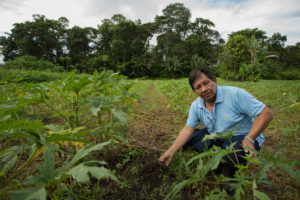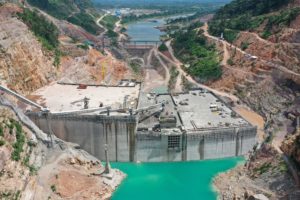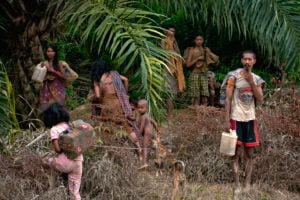Natural and versatile – it is made into edible pulp, powder, and capsules, into cosmetic creams and even perfumes – it’s easy to see why people from the Brazilian Amazon are increasingly saying of their native palm fruit açaí that is “has won over the world”.
Already called a superfood because of its nutritional values, the açaí berry is produced without deforesting, leading some experts to identify it as one of the most promising paths for sustainable development in the world’s largest tropical forest.
But behind the enthusiasm, there is a long way to go. Without investment, national production cannot meet ever-increasing domestic demand, let alone the world’s.
99%
of the açaí Brazil produces is consumed domestically
In 2019, Brazil produced 1.4 million tonnes of açaí, according to the Brazilian Institute of Geography and Statistics (IBGE). The country exported less than 1% of that. Levels are currently well below other superfood fruits such as pomegranate, production of which in India alone, the top producer, exceeds 2.2 million tonnes.
But for the last four years, producers have been striving to cultivate a taste for açaí in China, the world’s largest consumer market. Eyeing an urbanised Chinese consumer base with more adventurous eating habits, especially young people, the Brazilian Export and Investment Promotion Agency has been promoting açaí in China since 2017.
They have already had some small victories. This year, OakBerry Açaí Bowls, one of the world’s leading açaí sellers, opened a shop in a Shanghai mall, one China’s largest, and now sells açaí mix – a sweet frozen mixture of pulp and water, guaraná syrup, flavourings and stabilisers. The company also wants to distribute the ready-made product to supermarkets and to open four more shops by 2021, including in Beijing and Hong Kong.

“We have a committed consumer base, formed mainly by the community around the shop, who work in the perimeter of the mall,” explains Karim Fahs, an OakBerry franchisee in China. But the challenge for foreign traders of making açaí known in a country without Google, Facebook or Instagram is considerable. “We don’t know what’s on their internet. We need to make ourselves exist in the Chinese online world first.”
Other producers are already able to export pulp to China in small quantities. At present, Brazilian suppliers are ill-prepared for even a small increase in demand from China.
Ivan Saiki, who has been exporting the fruit for 15 years but not to China, says that even if a chunk of its population were to consume a minimal amount per person per year on average, there would be “no way” to meet demand. Saiki calls for investment, support, and a policy of incentives to create a global production chain.
Açaí’s profits outside the Amazon
Much of the world’s consumption of açaí is in the form processed foods, including energy drinks and ice creams, which contain little of the berry in their final formulation and are often manufactured in other countries, such as the US. With a low level of industrialisation in the açaí chain nationally, Brazil has a way to go before it can dominate the global market.
Of the US$15 billion that the açaí market moves worldwide, only $1 billion returns to the Amazon
“The problem with not investing in our native products is that there are those who want to do it [from] outside, whether in another state or in another country,” says agronomist Anecilene Buzaglo, who has 15 years of experience accompanying açaí producers in the Amazon. “It was like that with the rubber tree, cocoa and guaraná, just to name a few products native to the Amazon.”
The result is that Amazonian states benefit very little from the cultivation of açaí, despite housing almost all its production, says climate engineer Carlos Nobre, who advocates investment in technology to turn the Amazon into a bio-economic powerhouse.
“Of the US$15 billion that the açaí market moves worldwide, only $1 billion returns to the Amazon,” he says.
There is also a lack of investment in small producers, who produce açaí in Brazilian forests to increase their yields and meet growing domestic demand.
Cultivation and harvesting remain practically artisanal. Much of the açaí fruit comes from areas managed by native riverine peoples along the Amazon basin, according to Embrapa, the Brazilian Agricultural Research Corporation. Harvesting and transportation are especially difficult in the state of Pará, where areas often flood, making it difficult for boats to access. Often, it is necessary to manually load the basket with the fruit ventilated and opened so it does not ferment.
“The harvest based on plant extractivism is unstable, the price oscillates and the international market does not accept it. You have to have regular production all year round,” says Saiki.
Other challenges include precarious conditions for the transport of açaí to urban centres and poor storage that can generate losses that the Brazilian Association of Exporters of Fruit and Derivatives (Abrafrutas) estimates to be between 30% and 40% of production.
This is one of the bottlenecks for açaí production in Pará. In remote areas, the harvest can account for 50% of the total production cost, according to José Urano de Carvalho, a professor at Embrapa. So-called peconheiros climb palm trees over 12 metres high with braided straw to support their feet and no safety equipment.
In Amazonas state, considered a promising market because of the pulp yield from the native Euterpe precatória species, which is almost twice that of the species found in the state of Pará (Euterpe oleracea), there are other obstacles. The question of land ‘regularisation’ (or ownership through formal titling), can impede access to credit, the production of seedlings and research, according to Luiz Herval Filho, director of Technical Assistance and Rural Extension at the Amazonas State Institute for Sustainable Agriculture and Forestry Development (IDAM).
“It takes one year to grow a seedling ready for planting…five more to start producing fruit on a commercial scale,” he says.
Açaí in Brazil: A path toward sustainable development
Embrapa’s Carvalho explains that 100,000 hectares of firm land would suffice to double the current production of açaí in Pará. This represents a fraction of the 500,000 hectares occupied by soybeans in the state. Accessing this land should be straightforward since açaí cultivation can take place in degraded pasture areas, which exceed 200 million hectares in Brazil.
“No hectare of açaizeiro [açaí palm] established on land in the Amazon has been planted in primary forest,” says Carvalho, adding that all plantations occupy areas of degraded former pastureland or crop fields that were no longer of interest to farmers.
Investments in açaí would also strengthen communities whose livelihoods are based on natural resources, who today occupy 8.1 million hectares of public forest in the Amazon biome. These areas have been established as ‘extractive reserves’, or conservation units for sustainable use. They are managed by councils composed of local communities, government institutions and non-governmental organisations.

Although extractive reserves have existed in Brazil since 1988, most families still have low incomes and are gradually expanding extensive cattle ranching as a source of revenue, adding to the pressure to deforest, according to a report by the Amazon Institute for Environmental Research (IPAM).
But the cultivation of açaí – along with native fruits such as cocoa and chestnut – is up to twenty times more profitable than soy and meat production in the Amazon. A 2019 study by the Reference Centre for Innovative Techologies (CERTI) Foundation, showed that an açaí crop in an agroforestry system yields 12,400 reais/hectare per year (US$2,300), while meat and soy yields 604 reais/hectare ($112) per year.
Açaí also generates several co-products that could be used by local industry. Antônio Mesquita, of the University of the State of Amazonas (UEA), discovered that the fruit seed can produce MDF-type panels that are more resistant than the commonly used eucalyptus.
Votorantim Cimentos, a cement company that signed a sectoral pact to eliminate carbon emissions in production by 2050, has replaced fossil fuels with açaí seed in boiler engines in one of its units in Pará. The operation gets through 70,000 tonnes of seed per year.
“Why not bring the fourth generation technologies to stimulate industry in the Amazon in a decentralised manner and build the capacity of rural and urban populations to participate in a bio-industrial model?” asks Nobre.
“There must be public policies and great interest from Brazilian industry to break the cultural tradition that the Amazon must be a supplier of primary products”.









